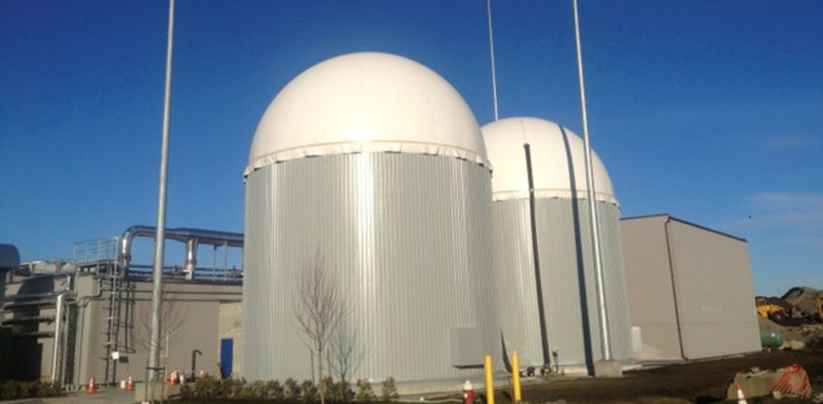Urban Waste to Electricity Demonstration
Lead proponent: Harvest Power (formerly Fraser Richmond Soil & Fibre)
Location: Richmond, BC
CEF contribution: $ 5 M
Project total: $ 22.5 M
Project Background

In these digestion tanks naturally occurring bacteria convert
the starches, fats and sugars into biogas, collected at the top.
As population continues to grow, and resources become increasingly scarce, the demand has increased for innovative recycling technologies that sustain our standard of living while preserving our environment for future generations. Although recycling of paper, plastics and metals is very well established, organics recycling infrastructure lags. With increasing pressures to divert organics found in our waste streams, there are increasing demands to process those materials in a sustainable and beneficial manner.
Aerobic composting typically uses leaf and yard waste as the primary feedstock, with up to 10% food waste mixed in. Due to the dense composition and odourous nature of food waste as it biodegrades, it is challenging to aerobically compost large quantities of food waste in densely-populated areas. Furthermore, although composting retains and recycles soil nutrients, it captures no energy. The energy in organics can be captured through anaerobic digestion (“AD”) - converting the sugars and starches from food waste into biogas, which can then be used to produce electricity. Although anaerobic digestion has historically been used to treat sewage sludge and manure (organic materials with low solids content), it has not previously been used in Canada to treat a mixed organics stream of yard and food waste.
To respond to the need to process mixed food scraps and yard trimmings while capturing the energetic capacity of those materials, Harvest Power set out to develop Canada’s first ever high solids anaerobic digester (HSAD). The Clean Energy Fund contributed $5M towards the “Urban Renewal Bioenergy Production” project, whereby Harvest would develop, construct, and demonstrate the technical and commercial viability of HSAD for producing energy from food and yard waste.
Results
Harvest developed and constructed a two-stage batch HSAD. In this system, the hydrolysis and methanogenesis stages were separated so that each could be operated under optimal loading rates and pH levels. As a result, the system had a shorter solids retention time, and the hydrolysis stage could operate quickly - the overall process required approximately half as much time (14 days) as compared to a conventional single-stage AD process. The decrease in digestion time allowed the system to process more feedstock per year. Harvest’s system was initially designed for an input capacity of 27,000 tonnes per annum (tpa), consisting of food and yard waste. The HSAD was expected to yield 17,687 tpa of high-quality, marketable compost, to be produced by aerobically composting residuals from the digestion process (called “digestate”). The demonstration system was able to consistently process feedstock rates at or above the design rate of 27,000 tpa, and produce at or above the expected yield of compost.
In a two-stage HSAD, most biogas is collected from the methanation digester. Depending on feedstock, a two-stage process produces biogas with 65 - 80% methane concentration (with less dilution by CO2), compared to typical single-stage methane concentrations of 52 - 62%. The biogas from Harvest’s HSAD was designed to be combusted on-site in a 1 MW (electrical output) combined heat and power generator, and expected to generate a net electrical output of 6,789 MWh/yr with an available thermal output of 55,956 MMBtu/yr. The demonstration system was able to produce at, and sometimes above the projected output during the first year. Subsequent to the first year, a series of optimization steps were taken to improve the consistency and yield of the energy output while maintaining high levels of feedstock throughput.
Benefits to Canada
Market penetration of AD systems in Canada will occur as utilities, environmental permitting regulators, and waste generators and haulers gain confidence in the viability of HSADs. This facility successfully demonstrated a HSAD system for processing food and yard waste into clean energy and compost, which could be replicated across the country.
Next Steps
Harvest Power intends to further optimize the current facility to increase throughput and biogas yields, and look to develop additional HSAD projects in Canada to leverage the lessons learned from this project.
- Please contact the Clean Energy Fund program to obtain a copy of the Harvest Power Completion Report.
Page details
- Date modified: